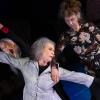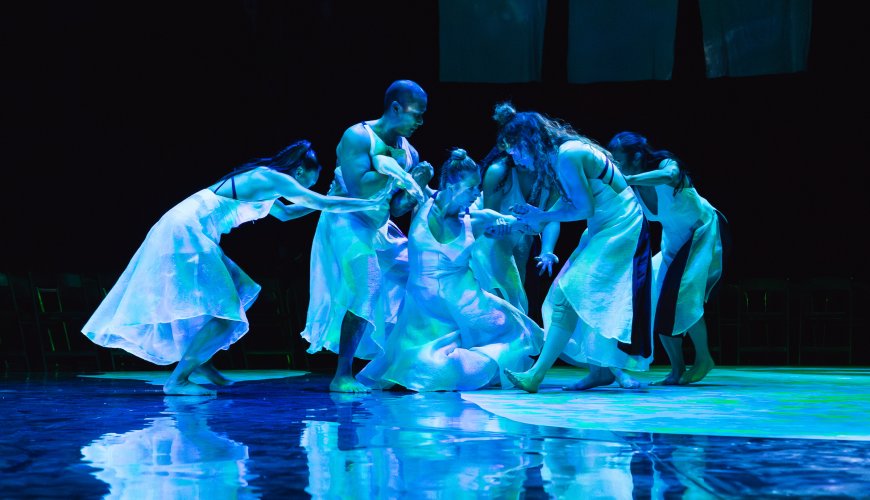
Eight dancers are scattered about the stage, turned in toward center, standing with the sort of grounded, intent readiness that only exquisitely trained performers can pull off. The audience frames them on all sides of Z Space’s Steindler Stage, sitting two or three rows deep, waiting. Watching. Getting ready.
It is one of those quintessential live-theater moments, this pause. Or perhaps “pause” is the wrong word because the thing that most characterizes the stillness is its potential — the burgeoning anticipation of what is to come. There’s a palpable buildup of potential energy when performers and performance-goers sit together before the official action begins. The lights have dimmed, the chatter stilled. The dancers sweep forth.
And this suspension at the tip-top of Margaret Jenkins Dance Company’s Wheel — with these dancers, these witnesses, this cultural melee — is already a thing of beauty. This viewer caught the opening-night performance on Thursday, May 1.
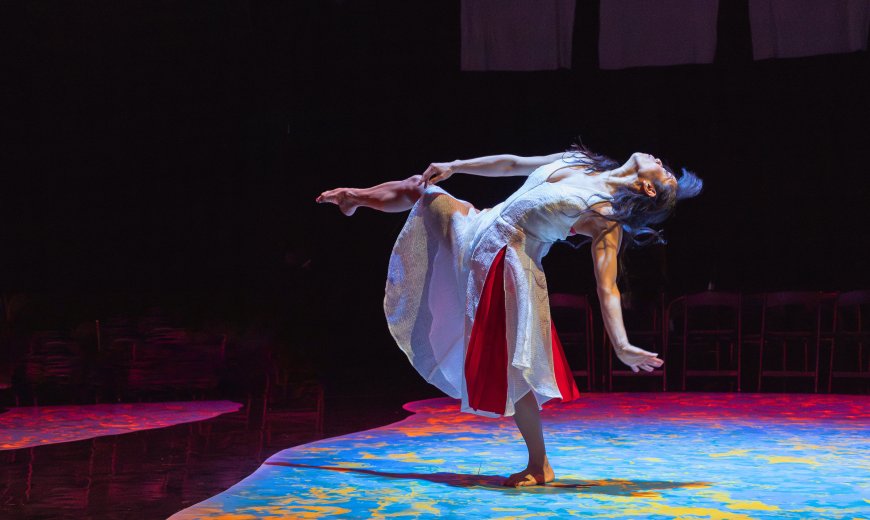
Wheel begins in darkness, with whispers. A leaning body, a flicked gesture of the arm, a rotated spine that leans an ear in toward someone across the space. Then a return to a state of readiness, to a listening that occupies the whole body. Each dancer moves intermittently, as if in conversation with the others. They’re still separate forms, they’ve hardly moved from the spot where they began, but they are, it seems, kinesthetically attuning.
The action grows, as does the sonic landscape — whispers conjoin and build, and the dancers form constellations of movement with limbs curling around one another, feet walking together. The wheels are turning. The dancers are joined by composer-inventor Paul Dresher and percussionist Joel Davel, whose live original music creates a rich and varied current upon which we voyage.
The program is demanding for dancers and musicians alike. It’s a nonstop hour, though with a very satisfying ebb and flow. MJDC and collaborators seem to exist together inside a single breath. The music is intricate and unpredictable, unlike anything I’ve heard elsewhere. Dresher plays guitar and keyboard, and Davel plays Marimba Lumina, an electronic percussion instrument he helped design with longtime collaborator Don Buchla. Poetry by Michael Palmer anchors it all in a universe of unending questions, not the least of which is “Will we dance the darkness down?”
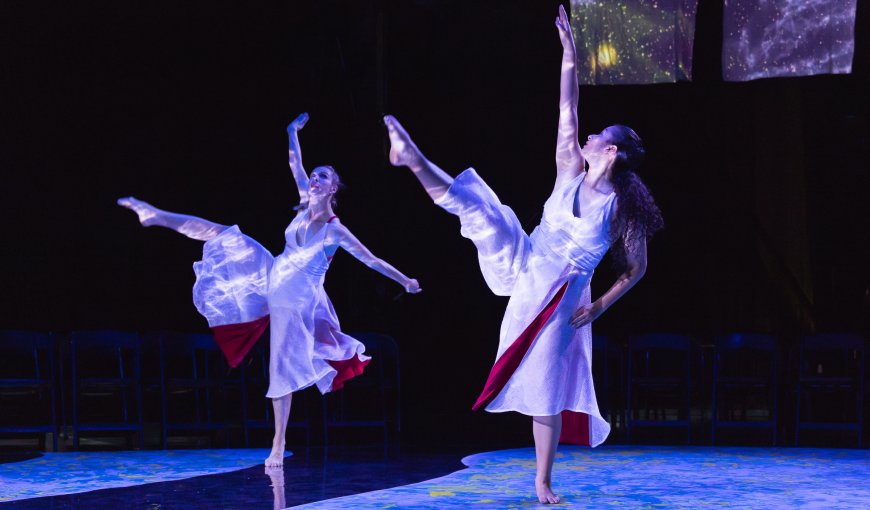
There’s an urgency to the work, though it’s not at all harried. There’s both precision and a sense of freedom in the movement, indicative of dancers who are deeply engrossed and invested. Collaboration is what ties MJDC so richly together. Choreographer Margaret Jenkins does not dictate the vocabulary or sequence but rather prioritizes having each dancer contribute to the building of a performance world that’s explored collectively.
It’s a world where we get to enjoy the performers’ singular strengths: Kelly Del Rosario’s sly smile and fluid strength, Tristan Ching Hartmann’s delicate laying on of hands, Anna Greenberg Gold’s deep lunges and intense gaze, and Allegra Bautista’s gloriously articulate flexed foot extended to the sky. Carolina Czechowska and Claire Fisher-Mendez lap up the space with voracity. Corey Brady and Raven Bautista steadily support the frame and occasionally burst forth with power. Each dancer alone is a superb mover — attentive, muscular, articulate, present.
And in the world of Wheel, these individuals are fundamentally essential yet move as a true ensemble, invested in and contributing to each other’s narratives. In this collaborative process, the dancers get a chance to rehearse the kind of world that should be possible. A world of radical belonging, engaged problem-solving, deeply entangled moving and being-with. A world stripped of hierarchy and characterized by care. A world that perhaps begins to redress the mess of isolation and conflict we so often find ourselves living in. In a brief interview, Jenkins attested to the fact that rehearsals are often healing for the dancers, a place where a way forward is always possible.
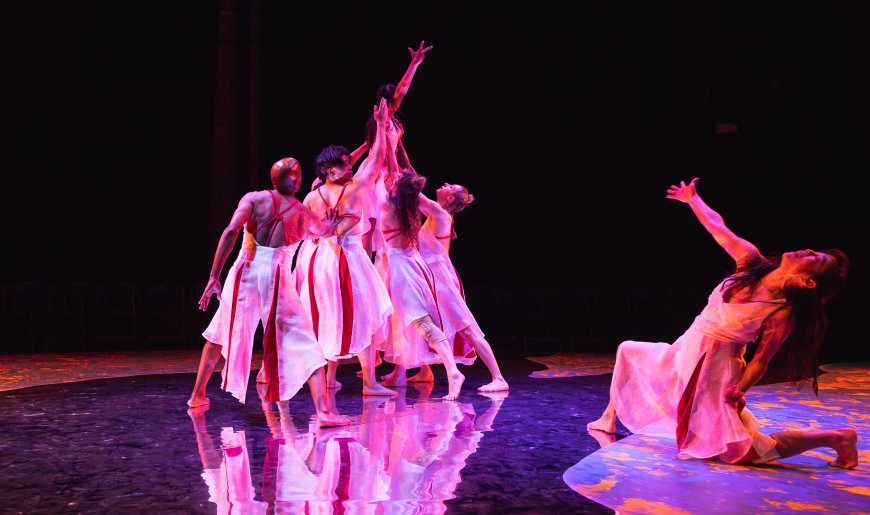
It should be said, there’s no literal wheel here. In fact, there’s nothing in Jack Beuttler’s production design that is immediately identifiable as a circle. Instead, the delineated spokes of Wheel are thematic metaphorical spheres through which we journey. A section titled “Wheel of Winds” unfurls with rhythm and purpose. The dancers move en masse, stamping their feet here, clapping their hands there, smiles spreading across their faces. “Wheel of Constellation” is a study in intimacy, with duets tracing the lines of hope, fear, rage, and grief for each pair of partners. On and on it goes: “Wheel of Rupture,” “Wheel of Memory,” “Wheel of Kites,” “Wheel of Currents.” The full company is engaged in each section, many of which open up space for stunning solos from different dancers. The way they support and envelop each other is engrossing, especially at close range.
If all this sounds heady, I suppose it is. But Wheel allows high concept in while somehow simultaneously eschewing the pretension that can accompany similarly styled work. As I explained to my 10-year-old, who accompanied me to (and enjoyed!) the show, this dance is structurally and tonally more a poem than a comic book, biography, or even work of fantasy. Wheel makes clear the 52 years of work that Jenkins has put into this company. The piece is evocative and layered, with an alchemical combination of introspection, collective action, mystery, and gravitas.




